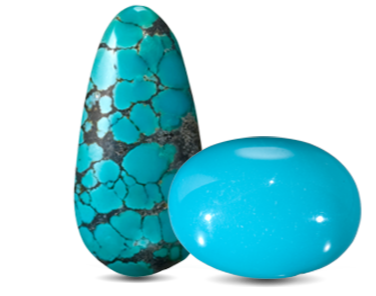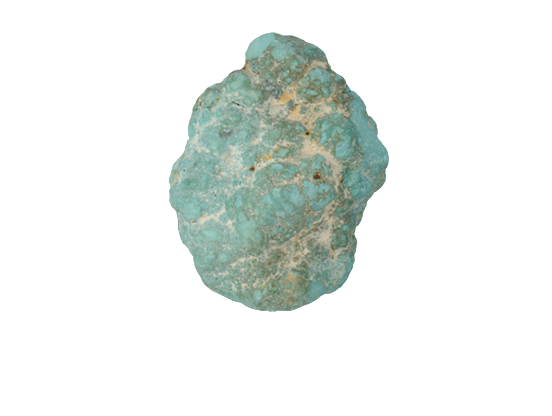Your Bag is Empty
Turquoise is the birthstone for December, and there's something about the choice that just fits. A stone unlike any other in colour, in texture, in feeling. It’s the kind of gem you recognise instantly – never mistaken, never quiet.
Ask someone what the December birthstone is, and odds are they’ll think of this unmistakable blue – calm but vibrant. Somewhere between sky and sea, it is threaded through with dark lines like maps. Worn for centuries and valued across cultures, the December birthstone has always been less about shine and more about soul.
Of all the stones linked to months, the December birthstone might be the most storied – and the most unmistakable.

Turquoise isn’t a modern discovery – it’s ancient. It was one of the first gemstones ever mined. It was found in the tombs of Egyptian pharaohs. It was traded along Silk Road caravans. It was inlaid into Persian armour, Tibetan spiritual objects, Mesoamerican masks, and Native American ceremonial jewellery. It appears wherever humans have looked for beauty and meaning.
The word traces back through French and Latin to “Turkish stone,” because early specimens reached Europe from mines in Persia through Turkish trade routes. But the cultures that gave December birthstone power reached much further back.
In Persia, it was worn as protection, set into sword hilts, and worn in rings to guard in battle. In Mesoamerica, the December birthstone was a gift for the gods, woven into offerings to speak directly with the divine. And in the American Southwest, which still carries immense cultural weight, it’s considered a stone of life, connection, and balance with the earth.
Throughout all of these – Egypt, Persia, the Americas – runs the same thread: turquoise wasn’t just decoration. It meant something. It still does.
As the birthstone for December, turquoise carries light, but not emptiness. It’s long been linked to open skies and clear speech. People wear it to be heard – not loudly, but truthfully. In many Native cultures, it’s seen as a bridge between earth and sky, between water and stone, spirit and body.
It’s often associated with healing, not in a vague or whimsical sense but as something grounding. It's the kind of stone you wear on days when you need to slow down and realign. It brings calm, softens emotional storms, and sharpens inner vision.
December birthstone has also earned its place as a stone of protection – not bracing but steadying, a shield drawn from the earth and sky.
Today, even outside ancient traditions, people are drawn to turquoise for its freshness. Its honesty. Its deep sense of place. And as a December birthstone, it adds something unexpected to winter – a colour that contains warmth, even in the cold.

What defines turquoise before anything else is colour, yet even that isn't simple.
The classic December birthstone color is an intense, slightly dry blue. Not the electric brilliance of sapphire, not the deep cool of aquamarine. December birthstone lives somewhere closer to the surface, full of softness, touched with green, sometimes warmed by earth tones. It’s a colour people have tried to replicate for centuries and never quite caught.
But the stone has more than just hue. It has a matrix – that’s what you call the veining and webs that run across certain specimens. These lines, brown to black, aren’t flaws – they’re part of the stone’s story. They hint at the rock around it, where it formed, and what it passed through.
Other key properties:
The best December birthstone is natural, vibrant, and untreated, though such stones are increasingly rare and highly valued.
December birthstone’s history is written across objects that still exist today – kept in museums, temples, or passed quietly from generation to generation.
In ancient Egypt, turquoise adorned Tutankhamun's burial mask and the queens' jewelry. Some pieces are over 3,000 years old and still have the same soft glow. In Mesoamerica, the Aztec “Fire Serpent” mosaics are among the most powerful December Birthstone creations ever made – each small tile crafted with intention, lit from within.
Closer to the present, Navajo, Zuni, and Hopi artisans have transformed December birthstone into handmade silver jewellery – cuffs, rings, shadowboxes – that are as much heritage as adornment. These pieces don’t just hold value; they carry memory. They reflect the land.
You’ll also find turquoise carved into prayer beads in Tibet, set into weapons across Asia, or worked into belts and buckles in the American West.
One stone. Every culture. Different meanings. Same presence
Turquoise, as the December birthstone, isn’t smooth, cold, or simple–not in form or meaning. It keeps a little dust in its colour, a little heat even in bright light. That’s part of why it lasts – not just in material but in spirit.
It’s not a polished gem that speaks of perfection. It’s something else. Something older, more grounded. A small, quiet reminder of where sky meets earth.